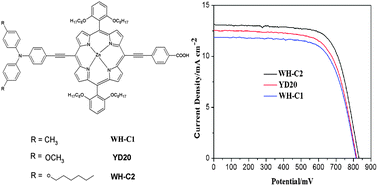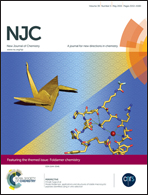The effect of different alkyl chains on the photovoltaic performance of D–π–A porphyrin-sensitized solar cells
Abstract
In this study, a series of novel D–π–A porphyrin sensitizers with different alkyl chains were designed and synthesized for dye-sensitized solar cells. The effects of different alkyl chains (methyl, methoxyl and hexyloxy groups) on the photophysical, electrochemical and photovoltaic performance were investigated systematically. The results indicate that the molar extinction coefficients of three dyes normally increase as the alkyl chain length increases. Furthermore, it is also found that the incident photo-to-current conversion efficiencies (IPCEs), short circuit current (Jsc) and open circuit voltage (Voc) of the dye-sensitized solar cells (DSSCs) based on WH-C1, YD20 and WH-C2 increase with the elongation of alkyl chains in the order of WH-C1 < YD20 < WH-C2. Accordingly, under standard global air mass 1.5 solar conditions, the optimized WH-C2-sensitized cell could produce a high conversion efficiency (η) of 7.77%, with a Jsc of 13.10 mA cm−2, a Voc of 831.10 mV, and a fill factor (FF) of 0.70.


 Please wait while we load your content...
Please wait while we load your content...